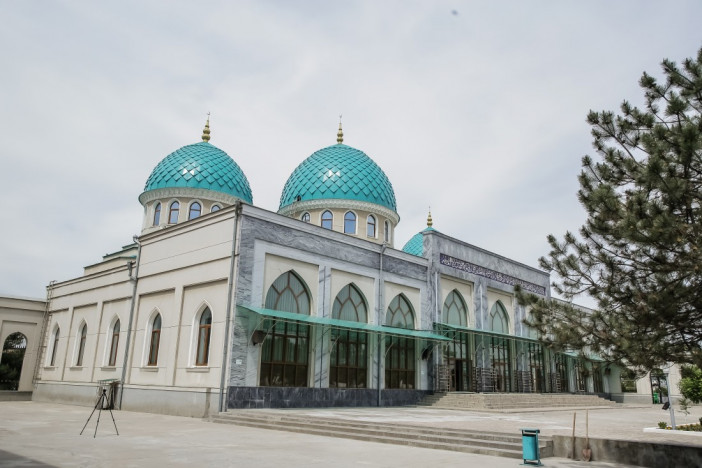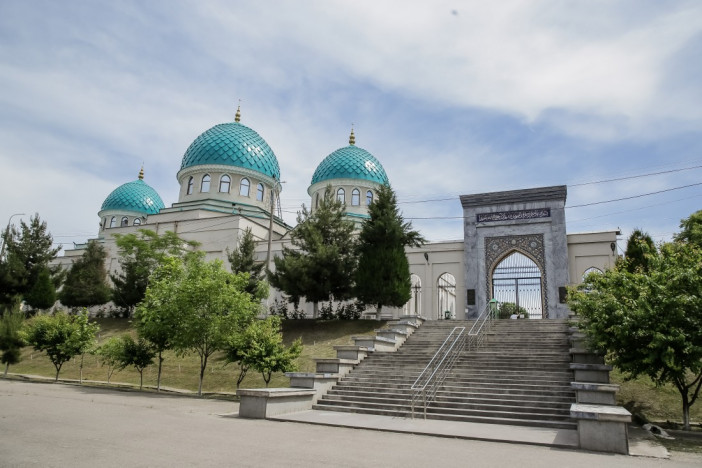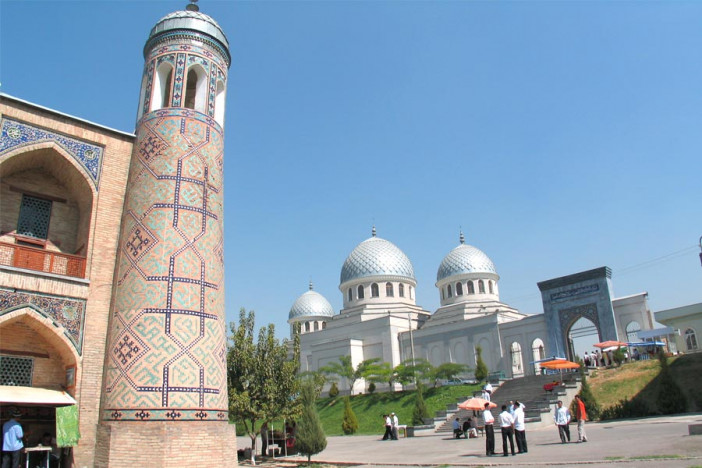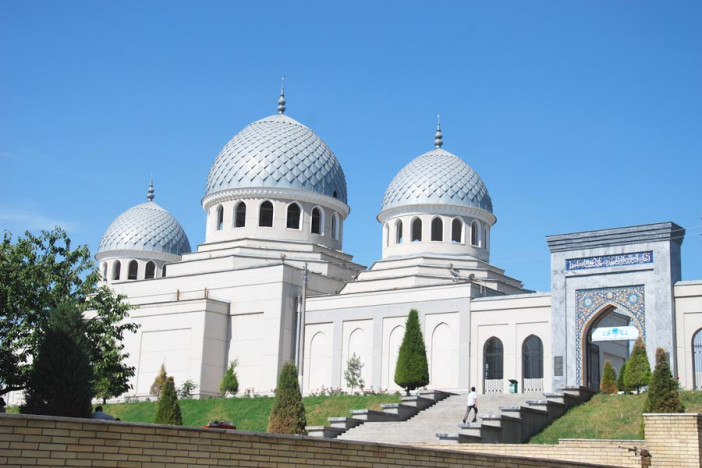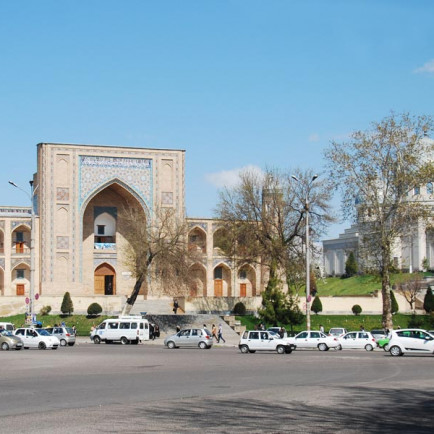KHOJA AKHRAR VALI MOSQUE
History
In the 8th century after the Arab conquest of ancient, Zoroastrian Tashkent the foundation for the mosque was laid. Tashkent which was called then Chach lay in ruins. Arab newcomers gave to the city the new name "ash-Shash", having distorted Chach - since in Arab there was no sound of "h".
"… In 819 the young emir Yakhjya ibn Assad who just received from the Arab deputy of east part of the caliphate the appointed diploma on management of all lands of the present Tashkent region stopped the horse at the height which and now is clearly looked through between three city squares enough – Chorsu, Hodra and Iski-Dzhuva. The first building of the Tashkent mosque (Juma masjidi) of Dzhum (The main Friday mosque) was built in 1451 at the expense of Sheikh Ubaydulla Hodzhi Akhrar (Akhror) (1404-1490).
Ubaydulla Akhrar - great the master of Sufism, the head of Muslim clergy and the prophet Mahomed's descendant, preparing for moving, Gulbazar ordered to build the big Friday mosque and madrasah in an ancient Tashkent makhalla. In local legends claim that Ubaydulla helped out money on construction from sale of "threads scraps" which remain after a fabric section on standard pieces.
The main Friday mosque was built on the hill; therefore it was possible to see this majestic building from long distance. Since then and about one today people call this mosque, Ubaydulla Akhror's mosque, in memory of him.
In 1868 the mosque was strongly damaged by a destructive earthquake. In 20 years, in 1888 it was finally restored on the means provided by the Russian emperor Alexander III from military contribution of the Emir Bukhara therefore its began to call the Imperial mosque.
Political events, such as Soviet atheistic mode, led to final fracture of the mosque. Ruins were finally demolished in 1997.
In 2003 the mosque was newly built up on the same place with application of modern methods of construction and finishing. The Khoja Akhrar Vali mosque underwent a serious reconstruction in the XVIII and XIX centuries after catastrophic earthquakes which caused a damage to many buildings of the city. Following the earthquake of 1868, the mosque was left completely destroyed for 20 years, until the Russian emperor Alexander III assigned money for its restoration in the year of 1888. That is why it was called a Tsarist Mosque, for a long time after its restoration. In the Soviet period this Juma mosque was confiscated and used as an administrative building for the Ministry of Education and later by other public offices. The main cathedral mosque of Tashkent through a semicentenary was the Tillya Mosque on the Khast-Imam Place.
Urban and Architectural
The Khoja Akhrar Vali mosque was built in a form of 15-m cube which symbolizes the holy Kaaba, with a dome and arch span, open to the East. In pre-revolutionary Tashkent with its low-rise one- and two-storey houses, the Khoja Akhrar Vali mosque was the highest building from where the whole city could be observed. The last restoration of the Khoja Akhrar Vali mosque was performed in 90-s of the last century. The building was rebuilt anew by modern architects, its cube was demolished and instead of one dome there are three domes crowning the mosque now. The architectural ensemble surrounded the Khoja Akhrar Vali Juma Mosque except for the restored Kukeldash madrasah and a dome of the mahalla Gulbazar mosque, did not survive up to this date. One can only have an idea of the original appearance of this complex now by old pictures and photos.
Description
Hodge's mosque Akhrar Valya Khodja Akhrar Vali masjidi or Mosque Dzhami. Djami masjidi-an ensemble basis Registan near Chorsu Square. Only Tashkent sample of the Friday mosque of the domestic type widespread in Central Asia in the late Middle Ages. Description-The main building has the form of the cube blocked by a dome with four windows in the low cylinder. On east wall turned into the yard, the large arch is cut through. A border of arches and niches at an entrance aperture - lancet that is not characteristic to the Central Asian outline, rather Gothic.Planning of the mosque rectangular with the large building at the end of a longitudinal axis the East-West. Inside the cube, there was a mikhrab and a place for Imam. Also inside it, there were arched galleries with cells built around a long yard; a takhoratkhona is a place where the Muslims are performing ablutions before prayer. The mosque finish was ordinary without any rich decoration in order nothing could distract the faithful Muslim from his prayer, wherefore the women who only had the right to visit cemeteries and speak to a sheik rather than an imam, were not allowed to mosques.
References
https://www.advantour.com/uzbekistan/tashkent/khoja-ahrar-mosque.htm http://www.traveluzbekistan.uz/tour/index.php/en/sights-of-tashkent/907-khoja-akhrar-vali-mosque,
https://uzbekistan.travel/en/o/khoja-akhrar-vali-mosque-in-tashkent/
Details
Location
located in the area of the Chorsu Bazaar Square in Tashkent, Uzbekistan
Year of Build
1451
Drawings
Map
History
In the 8th century after the Arab conquest of ancient, Zoroastrian Tashkent the foundation for the mosque was laid. Tashkent which was called then Chach lay in ruins. Arab newcomers gave to the city the new name "ash-Shash", having distorted Chach - since in Arab there was no sound of "h".
"… In 819 the young emir Yakhjya ibn Assad who just received from the Arab deputy of east part of the caliphate the appointed diploma on management of all lands of the present Tashkent region stopped the horse at the height which and now is clearly looked through between three city squares enough – Chorsu, Hodra and Iski-Dzhuva. The first building of the Tashkent mosque (Juma masjidi) of Dzhum (The main Friday mosque) was built in 1451 at the expense of Sheikh Ubaydulla Hodzhi Akhrar (Akhror) (1404-1490).
Ubaydulla Akhrar - great the master of Sufism, the head of Muslim clergy and the prophet Mahomed's descendant, preparing for moving, Gulbazar ordered to build the big Friday mosque and madrasah in an ancient Tashkent makhalla. In local legends claim that Ubaydulla helped out money on construction from sale of "threads scraps" which remain after a fabric section on standard pieces.
The main Friday mosque was built on the hill; therefore it was possible to see this majestic building from long distance. Since then and about one today people call this mosque, Ubaydulla Akhror's mosque, in memory of him.
In 1868 the mosque was strongly damaged by a destructive earthquake. In 20 years, in 1888 it was finally restored on the means provided by the Russian emperor Alexander III from military contribution of the Emir Bukhara therefore its began to call the Imperial mosque.
Political events, such as Soviet atheistic mode, led to final fracture of the mosque. Ruins were finally demolished in 1997.
In 2003 the mosque was newly built up on the same place with application of modern methods of construction and finishing. The Khoja Akhrar Vali mosque underwent a serious reconstruction in the XVIII and XIX centuries after catastrophic earthquakes which caused a damage to many buildings of the city. Following the earthquake of 1868, the mosque was left completely destroyed for 20 years, until the Russian emperor Alexander III assigned money for its restoration in the year of 1888. That is why it was called a Tsarist Mosque, for a long time after its restoration. In the Soviet period this Juma mosque was confiscated and used as an administrative building for the Ministry of Education and later by other public offices. The main cathedral mosque of Tashkent through a semicentenary was the Tillya Mosque on the Khast-Imam Place.
Urban and Architectural
The Khoja Akhrar Vali mosque was built in a form of 15-m cube which symbolizes the holy Kaaba, with a dome and arch span, open to the East. In pre-revolutionary Tashkent with its low-rise one- and two-storey houses, the Khoja Akhrar Vali mosque was the highest building from where the whole city could be observed. The last restoration of the Khoja Akhrar Vali mosque was performed in 90-s of the last century. The building was rebuilt anew by modern architects, its cube was demolished and instead of one dome there are three domes crowning the mosque now. The architectural ensemble surrounded the Khoja Akhrar Vali Juma Mosque except for the restored Kukeldash madrasah and a dome of the mahalla Gulbazar mosque, did not survive up to this date. One can only have an idea of the original appearance of this complex now by old pictures and photos.
Description
Hodge's mosque Akhrar Valya Khodja Akhrar Vali masjidi or Mosque Dzhami. Djami masjidi-an ensemble basis Registan near Chorsu Square. Only Tashkent sample of the Friday mosque of the domestic type widespread in Central Asia in the late Middle Ages. Description-The main building has the form of the cube blocked by a dome with four windows in the low cylinder. On east wall turned into the yard, the large arch is cut through. A border of arches and niches at an entrance aperture - lancet that is not characteristic to the Central Asian outline, rather Gothic.Planning of the mosque rectangular with the large building at the end of a longitudinal axis the East-West. Inside the cube, there was a mikhrab and a place for Imam. Also inside it, there were arched galleries with cells built around a long yard; a takhoratkhona is a place where the Muslims are performing ablutions before prayer. The mosque finish was ordinary without any rich decoration in order nothing could distract the faithful Muslim from his prayer, wherefore the women who only had the right to visit cemeteries and speak to a sheik rather than an imam, were not allowed to mosques.


